Fabrication and Tribological Properties of Diamond-like Carbon Film with Cr Doping by High-Power Impulse Magnetron Sputtering
Abstract
:1. Introduction
2. Experiment Details
3. Results and Discussion
4. Conclusions
Author Contributions
Funding
Institutional Review Board Statement
Informed Consent Statement
Data Availability Statement
Conflicts of Interest
References
- Sadeghpour, S.; Javaheri, V.; Bruschi, S.; Kömi, J.; Karjalainen, P. Strain rate and mechanical stability in determining deformation behavior of beta Ti alloys. Mater. Sci. Eng. A 2020, 798, 140274. [Google Scholar] [CrossRef]
- Ren, L.; Xiao, W.; Kent, D.; Wan, M.; Ma, C.; Zhou, L. Simultaneously enhanced strength and ductility in a metastable β-Ti alloy by stress-induced hierarchical twin structure. Scr. Mater. 2020, 184, 6–11. [Google Scholar] [CrossRef]
- Shao, L.; Li, W.; Li, D.; Xie, G.; Zhang, C.; Zhang, C.; Huang, J. A review on combustion behavior and mechanism of Ti alloys for advanced aero-engine. J. Alloys Compd. 2023, 960, 170584. [Google Scholar] [CrossRef]
- Jain, S.; Parashar, V. Comparison of priori and posteriori approach of multi-objective optimization for wedm on Ti6Al4V alloy. Mater. Res. Express 2022, 9, 076504. [Google Scholar] [CrossRef]
- Zhang, B.; Cai, Z.; Gan, X.; Zhu, M.; Yu, H. Dual motion fretting wear behaviors of titanium and its alloy in artificial saliva. Trans. Nonferr. Met. Soc. China 2014, 24, 100–107. [Google Scholar] [CrossRef]
- Kashyap, V.; Ramkumar, P. DLC coating over pre-oxidized and textured Ti6Al4V for superior adhesion and tribo-performance of hip implant. Surf. Coat. Technol. 2022, 440, 128492. [Google Scholar] [CrossRef]
- Ghahramanzadeh Asl, H. Investigation of friction and wear performance on oxidized Ti6Al4V alloy at different temperatures by plasma oxidation method under ambient air and vacuum conditions. Vacuum 2020, 180, 109578. [Google Scholar] [CrossRef]
- Zhou, Z.-Y.; Liu, X.-B.; Zhuang, S.-G.; Yang, X.-H.; Wang, M.; Sun, C.-F. Preparation and high temperature tribological properties of laser in-situ synthesized self-lubricating composite coatings containing metal sulfides on Ti6Al4V alloy. Appl. Surf. Sci. 2019, 481, 209–218. [Google Scholar] [CrossRef]
- Kümmel, D.; Schneider, J.; Gumbsch, P. Influence of interstitial oxygen on the tribology of ti6al4v. Tribol. Lett. 2020, 68, 96. [Google Scholar] [CrossRef]
- Wang, J.; Ma, J.; Huang, W.; Wang, L.; He, H.; Liu, C. The investigation of the structures and tribological properties of f-dlc coatings deposited on Ti-6Al-4V alloys. Surf. Coat. Technol. 2017, 316, 22–29. [Google Scholar] [CrossRef]
- Zhang, S.; Huang, T.; Sun, S.; Wu, S.; Yang, X.; Guo, F.; Zhang, B.; Dai, L. Effects of bias voltages on the tribological behaviors of DLC Coatings. Coatings 2024, 14, 176. [Google Scholar] [CrossRef]
- Wang, J.; Wang, L.; Chen, H.; Wang, H. Molecular dynamics simulation of friction in dlc films with different sp3 contents. Tribol. Int. 2023, 190, 109050. [Google Scholar] [CrossRef]
- Tillmann, W.; Wittig, A.; Dias, N.F.L.; Stangier, D.; Thomann, C.A.; Moldenhauer, H.; Debus, J. Silicon- and tungsten-containing hydrogen-free and hydrogenated amorphous carbon films for friction-reducing applications. Diam. Relat. Mater. 2022, 123, 108866. [Google Scholar] [CrossRef]
- Sha, B.; Lukianov, A.N.; Dusheiko, M.G.; Lozinskii, V.B.; Klyui, A.N.; Korbutyak, D.V.; Pritchin, S.E.; Klyui Nickolai, I. Carbon-rich amorphous silicon carbide and silicon carbonitride films for silicon-based photoelectric devices and optical elements: Application from uv to mid-ir spectral range. Opt. Mater. 2020, 106, 109959. [Google Scholar] [CrossRef]
- Li, X.; Hou, K.; Qiu, D.; Yi, P.; Lai, X. A first principles and experimental study on the influence of nitrogen doping on the performance of amorphous carbon films for proton exchange membrane fuel cells. Carbon 2020, 167, 219–229. [Google Scholar] [CrossRef]
- Alotaibi, S.; Nama Manjunatha, K.; Paul, S. Stability of hydrogenated amorphous carbon thin films for application in electronic devices. Diam. Relat. Mater. 2018, 90, 172–180. [Google Scholar] [CrossRef]
- Wu, J.; Wei, P.; Liu, G.; Chen, D.; Zhang, X.; Chen, T.; Liu, H. A comprehensive evaluation of DLC coating on gear bending fatigue, contact fatigue, and scuffing performance. Wear 2024, 536–537, 205177. [Google Scholar] [CrossRef]
- Ding, J.C.; Cheng, Y.; Zhang, S.; Wang, Q.; Zhang, T.F. Microstructure, mechanical and tribological properties of ti doped ta-c films deposited by a hybrid coating system. Diam. Relat. Mater. 2023, 131, 109565. [Google Scholar] [CrossRef]
- Ding, J.C.; Dai, W.; Zhang, T.F.; Zhao, P.; Yun, J.M.; Kim, K.H.; Wang, Q.M. Microstructure and properties of nb-doped diamond-like carbon films deposited by high power impulse magnetron sputtering. Thin Solid Films 2018, 663, 159–167. [Google Scholar] [CrossRef]
- Guo, C.-Q.; Li, H.-Q.; Peng, Y.-L.; Dai, M.-J.; Lin, S.-S.; Shi, Q.; Wei, C.-B. Residual stress and tribological behavior of hydrogen-free al-dlc films prepared by hipims under different bias voltages. Surf. Coat. Technol. 2022, 445, 128713. [Google Scholar] [CrossRef]
- Santiago, J.A.; Fernández-Martínez, I.; Sánchez-López, J.C.; Rojas, T.C.; Wennberg, A.; Bellido-González, V.; Molina-Aldareguia, J.M.; Monclús, M.A.; González-Arrabal, R. Tribomechanical properties of hard cr-doped dlc coatings deposited by low-frequency hipims. Surf. Coat. Technol. 2020, 382, 124899. [Google Scholar] [CrossRef]
- Jain, V.; Roychowdhury, T.; Kuimelis, R.G.; Linford, M.R. Differences in surface reactivity in two synthetic routes between hipims and dc magnetron sputtered carbon. Surf. Coat. Technol. 2019, 378, 125003. [Google Scholar] [CrossRef]
- Ma, D.; Harvey, T.J.; Wellman, R.G.; Ehiasarian, A.P.; Hovsepian, P.E.; Sugumaran, A.A.; Purandare, Y.P.; Wood, R.J.K. Cavitation erosion performance of cralyn/crn nanoscale multilayer coatings deposited on Ti6Al4V by hipims. J. Alloys Compd. 2019, 788, 719–728. [Google Scholar] [CrossRef]
- Costa, A.; Ferreira, F.; Colaux, J.L.; Vahidi, A.; Serra, R.; Oliveira, J. Effect of hydrogen incorporation on the mechanical properties of dlc films deposited by hipims in doms mode. Surf. Coat. Technol. 2023, 473, 129980. [Google Scholar] [CrossRef]
- Solomon, I.; Bhatnagar, M.; Shukla, K.; Sarma, B.; Ranjan, M.; Sarma, A. Correlation of structural and optical properties of pvd grown amorphous carbon thin films. Diam. Relat. Mater. 2017, 75, 69–77. [Google Scholar] [CrossRef]
- Kouznetsov, V.; Macák, K.; Schneider, J.M.; Helmersson, U.; Petrov, I. A novel pulsed magnetron sputter technique utilizing very high target power densities. Surf. Coat. Technol. 1999, 122, 290–293. [Google Scholar] [CrossRef]
- Ganesan, R.; Fernandez-Martinez, I.; Akhavan, B.; Matthews, D.T.A.; Sergachev, D.; Stueber, M.; McKenzie, D.R.; Bilek, M.M.M. Pulse length selection in bipolar hipims for high deposition rate of smooth, hard amorphous carbon films. Surf. Coat. Technol. 2023, 454, 129199. [Google Scholar] [CrossRef]
- Brenning, N.; Hajihoseini, H.; Rudolph, M.; Raadu, M.A.; Gudmundsson, J.T.; Minea, T.M.; Lundin, D. HiPIMS optimization by using mixed high-power and low-power pulsing. Plasma Sources Sci. Technol. 2021, 30, 015015. [Google Scholar] [CrossRef]
- Huo, C.; Lundin, D.; Raadu, M.A.; Anders, A.; Gudmundsson, J.T.; Brenning, N. On the road to self-sputtering in high power impulse magnetron sputtering: Particle balance and discharge characteristics. Plasma Sources Sci. Technol. 2014, 23, 025017. [Google Scholar] [CrossRef]
- Fernandes, F.; Calderon, V.S.; Ferreira, P.J.; Cavaleiro, A.; Oliveira, J.C. Low peak power deposition regime in hipims: Deposition of hard and dense nanocomposite Ti-Si-n films by doms without the need of energetic bombardment. Surf. Coat. Technol. 2020, 397, 125996. [Google Scholar] [CrossRef]
- Adelhelm, C.; Balden, M.; Rinke, M.; Stueber, M. Influence of doping (Ti, V, Zr, W) and annealing on the sp2 carbon structure of amorphous carbon films. J. Appl. Phys. 2009, 105, 033522. [Google Scholar] [CrossRef]
- Peng, Y.-L.; Guo, C.-Q.; Lin, S.-S.; Shi, Q.; Wei, C.-B.; Su, Y.-F.; Wu, Y.-Q.; Tang, P.; Zhu, X.-G.; Dai, M.-J. Effects of working pressure on structure and properties of al-containing amorphous carbon films prepared by high-power impulse magnetron sputtering. J. Alloys Compd. 2020, 816, 152587. [Google Scholar] [CrossRef]
- NIST X-ray Photoelectron Spectroscopy Database (SRD 20), Version 5.0. Available online: https://srdata.nist.gov/xps/EnergyTypeElement (accessed on 25 June 2024).
- Zhu, L.; Li, J.; Kang, J.; Tang, L.; Ma, G.; Han, C.; Shi, J.; Wang, H. Different cr contents on the microstructure and tribomechanical properties of multi-layered diamond-like carbon films prepared by unbalanced magnetron sputtering. J. Mater. Eng. Perform. 2020, 29, 7131–7140. [Google Scholar] [CrossRef]
- Yang, L.; Chen, Y.; Xu, Z.; Toshiaki, N.; Xi, Y.; Ni, Q. Effect of heat treatment on mechanical property of amorphous carbon films by magnetron sputtering. Diam. Relat. Mater. 2022, 129, 109328. [Google Scholar] [CrossRef]
- Tao, H.; Tsai, M.T.; Chen, H.-W.; Huang, J.C.; Duh, J.-G. Improving high-temperature tribological characteristics on nanocomposite cralsin coating by mo doping. Surf. Coat. Technol. 2018, 349, 752–756. [Google Scholar] [CrossRef]
- Dai, W.; Ke, P.; Wang, A. Microstructure and property evolution of cr-dlc films with different Cr content deposited by a hybrid beam technique. Vacuum 2011, 85, 792–797. [Google Scholar] [CrossRef]
- Zhou, Y.; Chen, Z.; Zhang, T.; Zhang, S.; Xing, X.; Yang, Q.; Li, D. Metastable hybridized structure transformation in amorphous carbon films during friction—A study combining experiments and MD simulation. Friction 2023, 11, 1708–1723. [Google Scholar] [CrossRef]




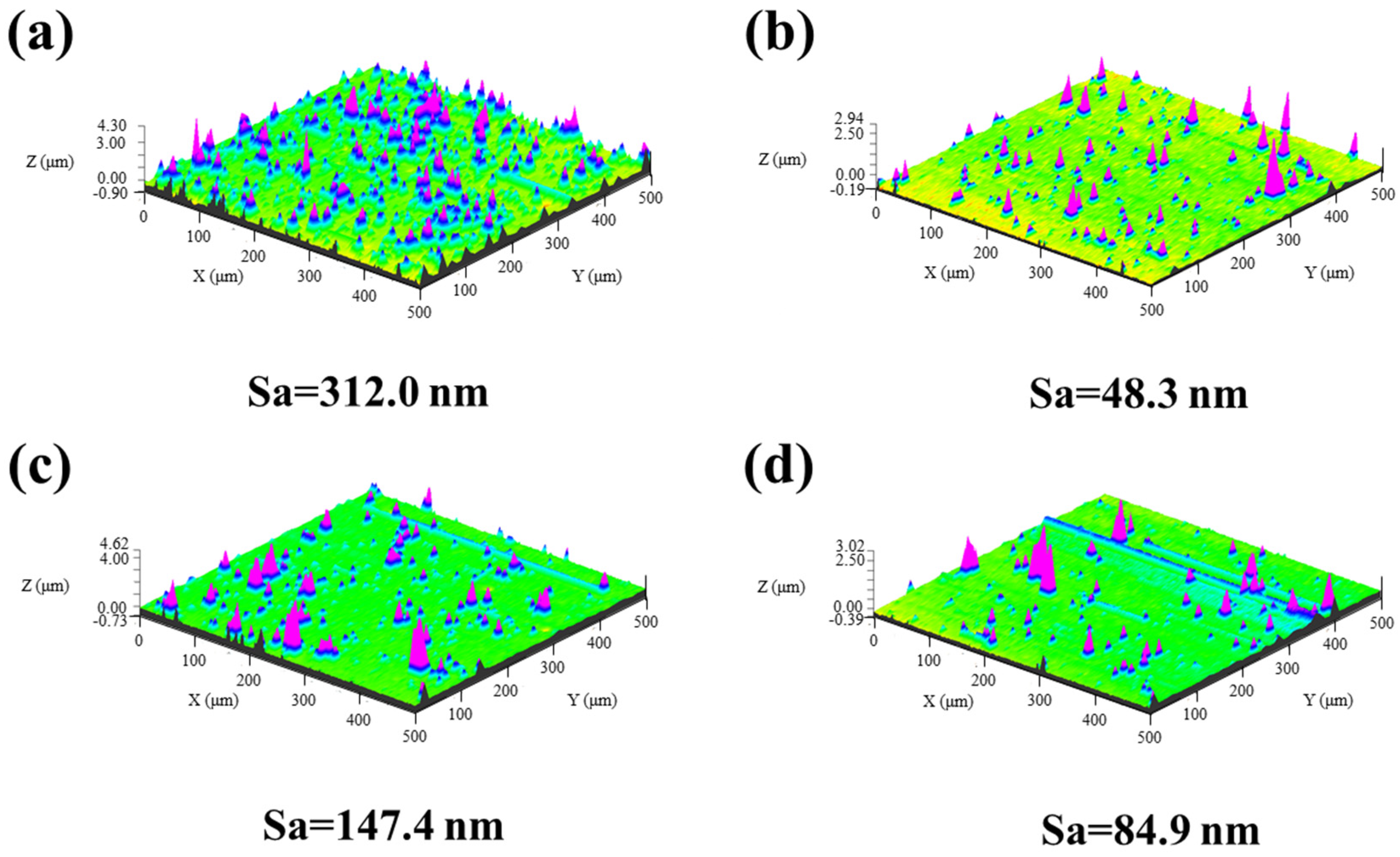
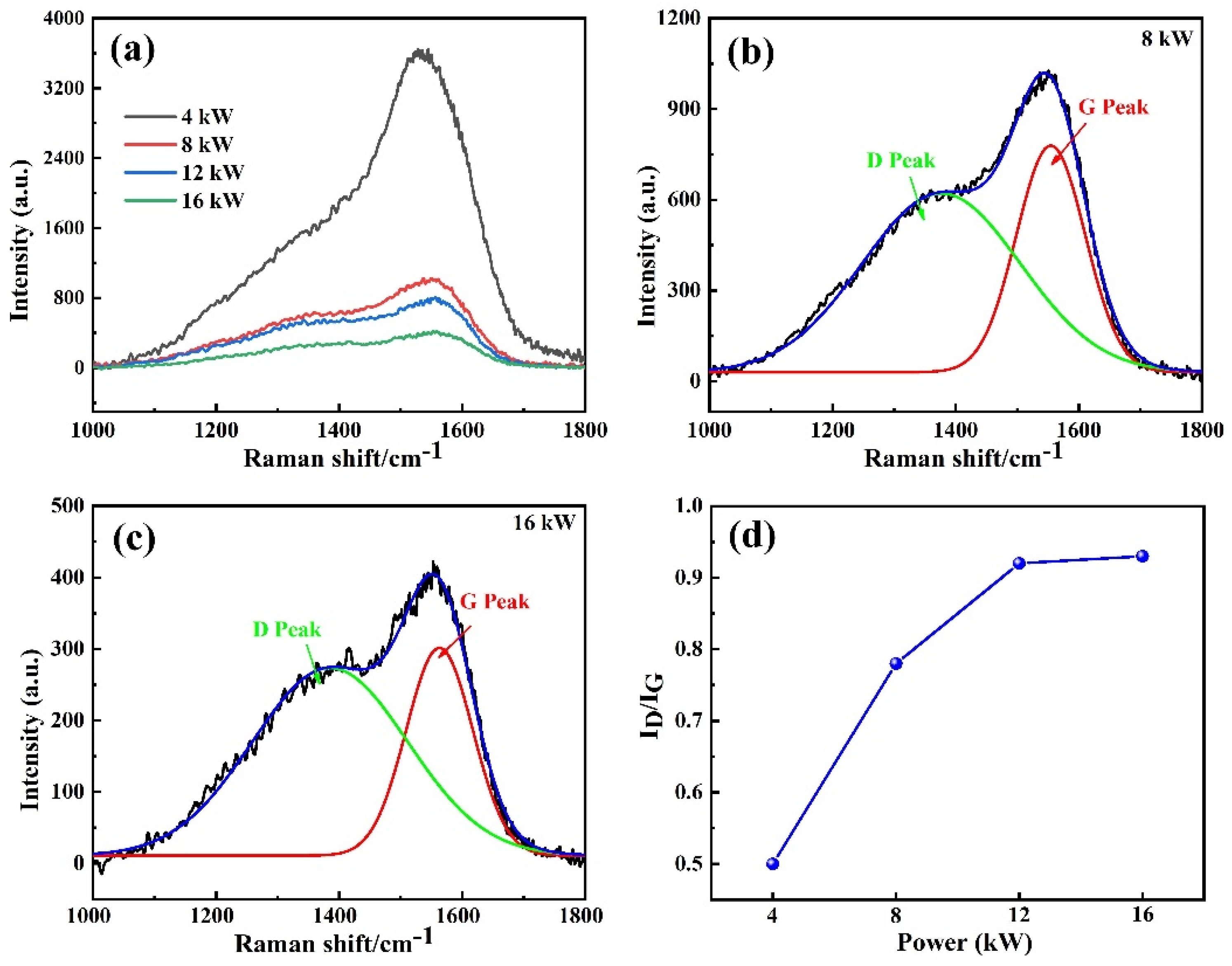
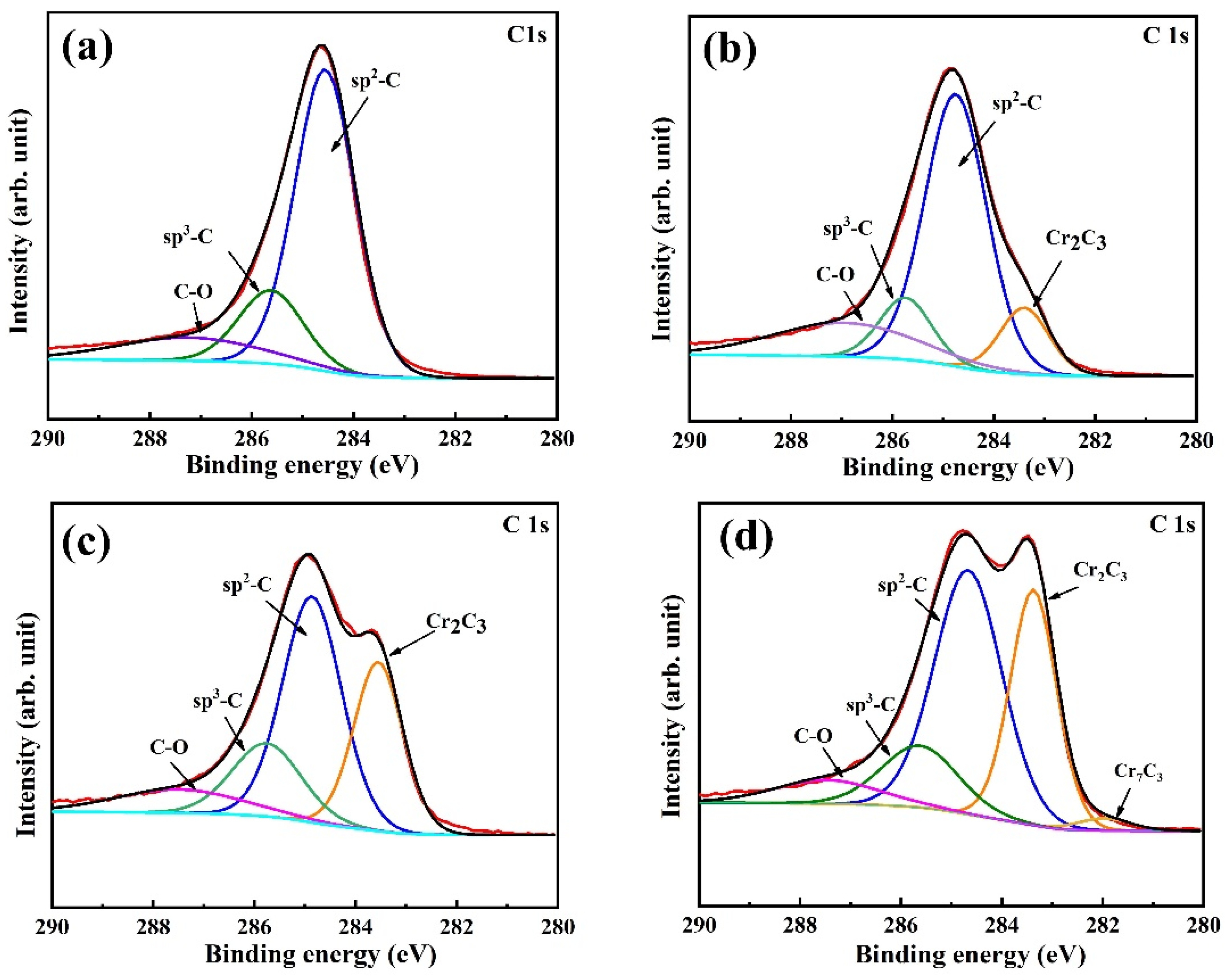

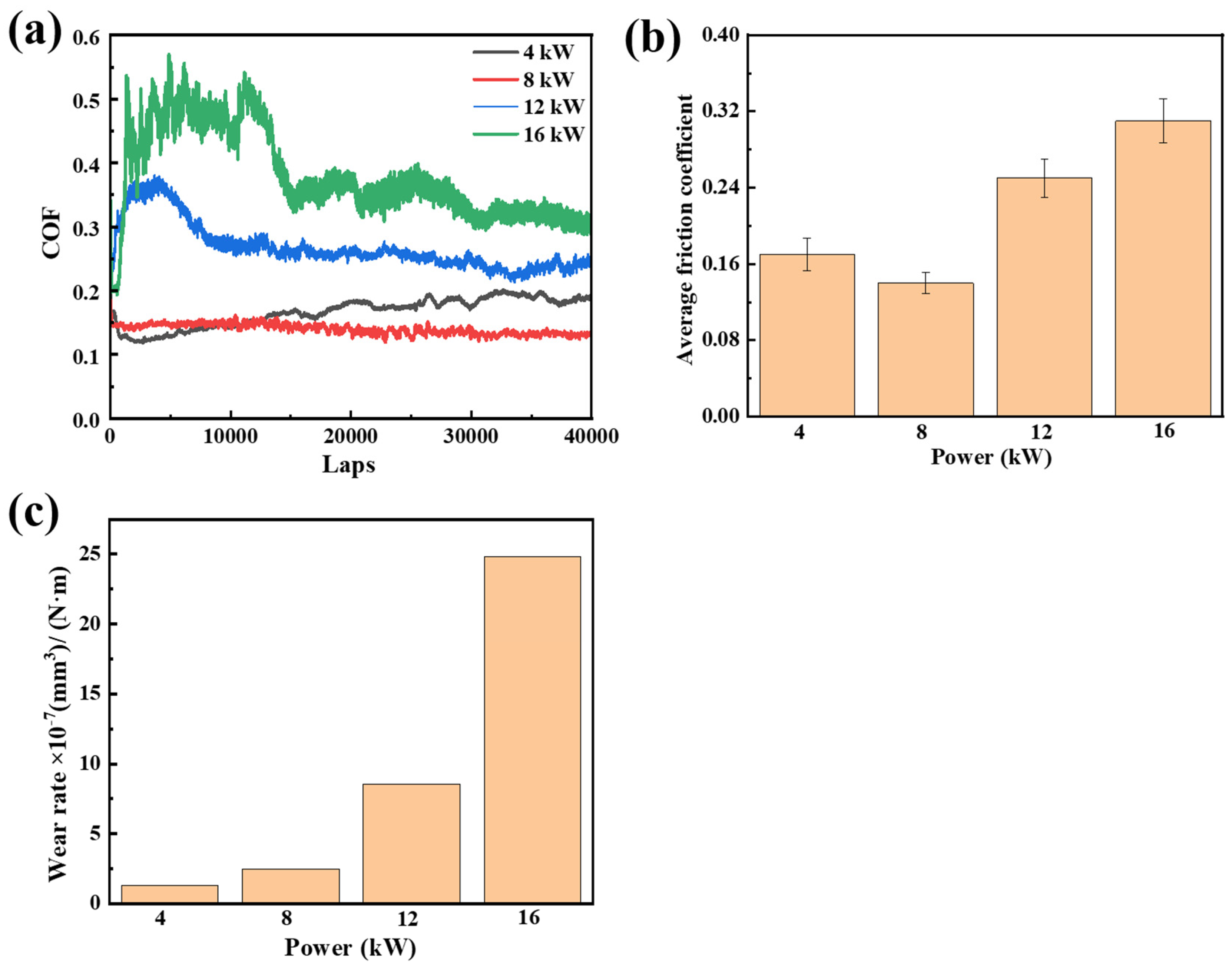

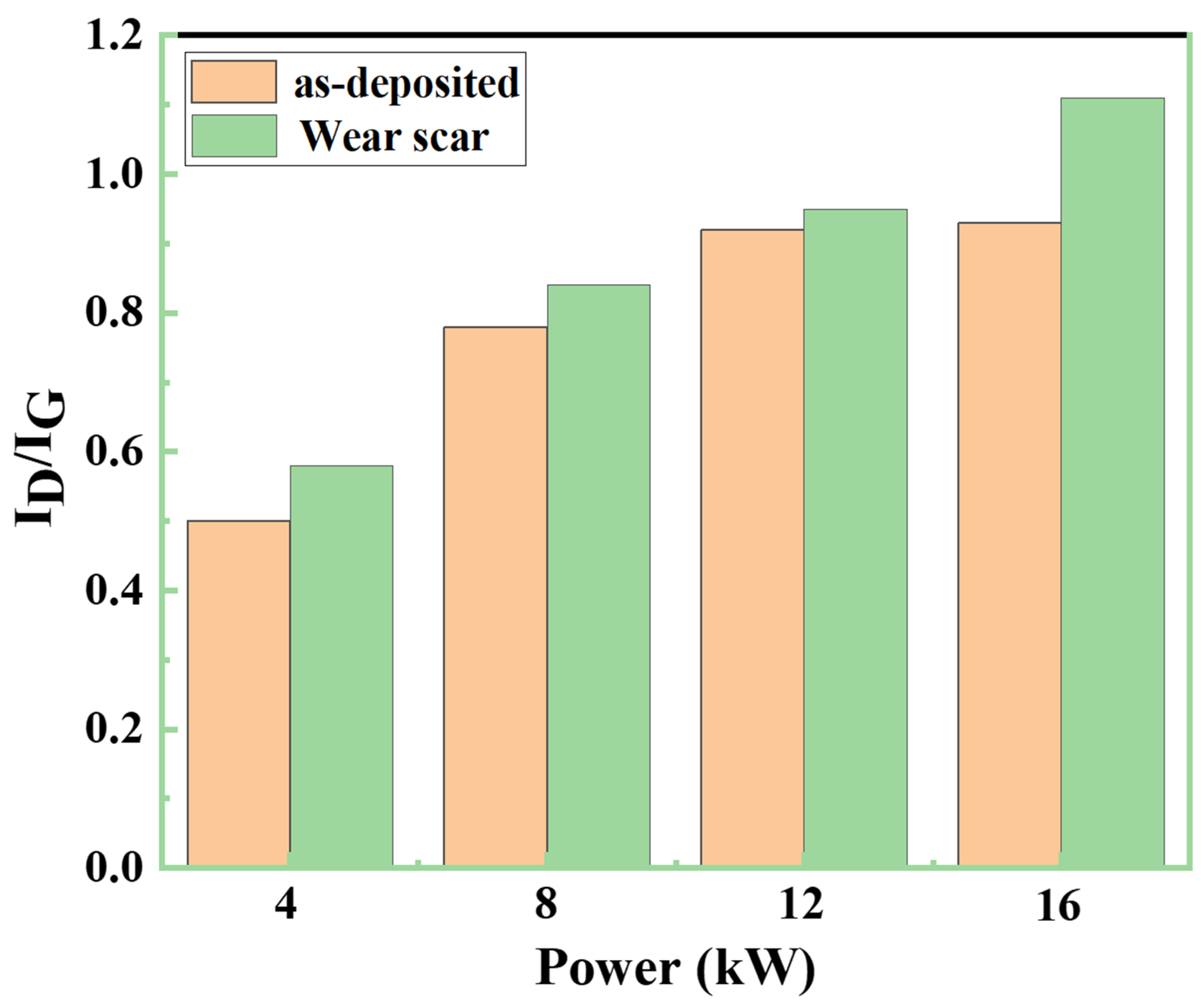
| Parameters | Cr | CrN | Cr-DLC |
|---|---|---|---|
| Base pressure (Pa) | 5.0 × 10−5 | 5.0 × 10−5 | 5.0 × 10−5 |
| Working pressure (Pa) | 0.5 | 0.5 | 0.5 |
| Bias voltage (V) | −50 | −50 | −100 |
| HiPIMS power (kW) | 15 | 15 | 4, 8, 12, 16 |
| Pulse length (μs) | 100 | 100 | 70 |
| Flow rate (sccm) | Ar: 300 | Ar/N2: 200/100 | Ar/C2H2: 150/300 |
| Deposition time (min) | 15 | 60 | 90 |
Disclaimer/Publisher’s Note: The statements, opinions and data contained in all publications are solely those of the individual author(s) and contributor(s) and not of MDPI and/or the editor(s). MDPI and/or the editor(s) disclaim responsibility for any injury to people or property resulting from any ideas, methods, instructions or products referred to in the content. |
© 2024 by the authors. Licensee MDPI, Basel, Switzerland. This article is an open access article distributed under the terms and conditions of the Creative Commons Attribution (CC BY) license (https://creativecommons.org/licenses/by/4.0/).
Share and Cite
Liu, S.; Zhuang, W.; Ding, J.; Liu, Y.; Yu, W.; Yang, Y.; Liu, X.; Yuan, J.; Zheng, J. Fabrication and Tribological Properties of Diamond-like Carbon Film with Cr Doping by High-Power Impulse Magnetron Sputtering. Coatings 2024, 14, 916. https://doi.org/10.3390/coatings14070916
Liu S, Zhuang W, Ding J, Liu Y, Yu W, Yang Y, Liu X, Yuan J, Zheng J. Fabrication and Tribological Properties of Diamond-like Carbon Film with Cr Doping by High-Power Impulse Magnetron Sputtering. Coatings. 2024; 14(7):916. https://doi.org/10.3390/coatings14070916
Chicago/Turabian StyleLiu, Shuai, Wenjian Zhuang, Jicheng Ding, Yuan Liu, Weibo Yu, Ying Yang, Xingguang Liu, Jing Yuan, and Jun Zheng. 2024. "Fabrication and Tribological Properties of Diamond-like Carbon Film with Cr Doping by High-Power Impulse Magnetron Sputtering" Coatings 14, no. 7: 916. https://doi.org/10.3390/coatings14070916




